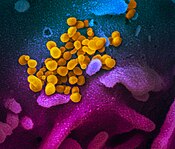COVID-19 may spread like flu, say scientists
Saturday, February 22, 2020
In a report released in The New England Journal of Medicine on Wednesday, scientists studying patients in Zhuhai in China's Guangdong Province reported that the newly emerged SARS-CoV-2, the coronavirus that causes COVID-19, may spread in a manner similar to influenza — suggesting, experts noted, that this outbreak, which began in the city of Wuhan in Hubei Province in December 2019, may call for containment measures similar to those for influenza.
Researchers used polyester swab samples from the noses and throats of eighteen infected volunteers, including one asymptomatic infected volunteer. They found the virus's behavior resembled that of influenza rather than severe acute respiratory syndrome (SARS), even though SARS-CoV-2 is more closely related to the viruses that cause SARS — hence its name — than to a typical influenza virus.
In humans, SARS viruses tend to live in the lower respiratory tract, where they can cause pneumonia. The COVID-19 virus, however, can live in both the lower and upper respiratory tract: the researchers found significant quantities of virus in samples taken from the volunteers' noses and throats. This and the fact that one of the volunteers had no symptoms while others had only mild ones raises the concern that, like a flu virus, SARS-CoV-2 could be spread directly from person to person by people who do not realize that they are putting others in danger.
Immunologist Kristian Andersen of Scripps Research said, in response to the study, "This virus is clearly much more capable of spreading between humans than any other novel coronavirus we've ever seen. This is more akin to the spread of flu[.]"
Efforts to contain the SARS outbreak, which took place in 2003, mainly involved preventing the spread of the virus within hospitals. If these findings are accurate, scientists say, containing COVID-19 may require a different approach.
The R0 number for SARS-CoV-2 — the number of other people to whom each infected person transmits the virus before either dying or becoming noncontagious — has yet to be calculated. R0 can change over time as populations become more resistant, more vaccinated, or more careful. For context, SARS-CoV has a basic R0 estimated in the range 2–4 and influenza in the range 2–3. The measles R0 is about 12–18. Ebola and HIV have R0 values of about 2. Generally, outbreaks with R0 values under 1 end on their own and those with values over 1 do not.
Related news
- "World Health Organization names new coronavirus COVID-19" — Wikinews, February 14, 2020
Sources
- Julie Steenhuysen. "New coronavirus spreads more like flu than SARS: Chinese study" — Reuters, February 20, 2020
- Lirong Zou, Feng Ruan, Mingxing Huang, Lijun Liang, Huitao Huang, Zhongsi Hong, Jianxiang Yu, Min Kang, Yingchao Song, Jinyu Xia, Qianfang Guo, Tie Song, Jianfeng He, Hui-Ling Yen, Malik Peiris, Jie Wu. "SARS-CoV-2 Viral Load in Upper Respiratory Specimens of Infected Patients" — New England Journal of Medicine, February 19, 2020
- Joseph Eisenberg. "R0: How Scientists Quantify the Intensity of an Outbreak Like Coronavirus and Its Pandemic Potential" — University of Michigan, February 12, 2020
- Jeffery DelViscio, Amanda Montañez, and Tanya Lewis. "Will the New Coronavirus Keep Spreading or Not? You Have to Know One Little Number" — Scientific American, February 5, 2020
- Michaeleen Doucleff. "No, Seriously, How Contagious Is Ebola?" — NPR, October 2, 2014


